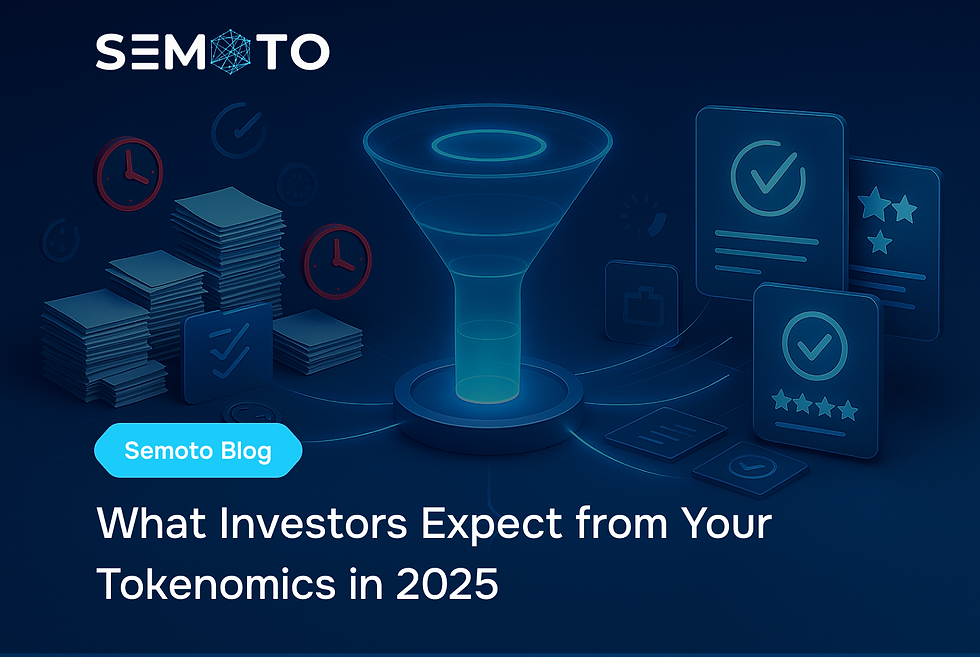What Investors Expect from Your Tokenomics in 2025
- Semoto

- Jul 23
- 3 min read

The blueprint for securing funding in the era of institutional Web3
🧠 TL;DR
Investors in 2025 don’t just want creative token mechanics - they want proof of sustainability, clear value accrual, and real alignment between your product roadmap and financial design.
In this blog, we break down what defines “investor-ready” tokenomics in today’s climate, and share case studies from both successful and failed launches.
1. Why Tokenomics Is Now a Diligence Priority
In the 2021–2022 cycle, investors tolerated loose models and vague emissions logic - often betting on community traction alone. But those days are gone.
Today, serious capital - from DAOs, VCs, and funds - treats tokenomics as foundational due diligence. If your token model isn’t audited, backtested, and presented like a business case, you're not getting the check.
2025 Investor Expectations:
Audited token flows and mechanics
Modeled treasury runway across cycles
On-chain vesting + DAO-governed distribution
Sustainable liquidity strategy
Real economic alignment across user, investor, and protocol
2. What “Investor-Ready” Tokenomics Looks Like
To secure funding, your token model must be more than just defensible. It must be a strategic lever that de-risks investor exposure and signals maturity.
✅ The New Standard:
Category | Expectation | Investor Red Flag |
Emission Schedule | Capped or decaying over time with clear purpose (e.g., growth → retention) | Infinite emissions, no usage-linked burn |
Liquidity Planning | Treasury-backed LP seeding, with exit incentives minimized | Total reliance on community-provided liquidity |
Use Cases | Aligned to revenue and user incentives | Utility exists only “on paper” |
Governance | Token-weighted governance tied to usage, not just holdings | Governance used only for optics |
Investor Alignment | Vesting, cliffs, and on-chain transparency | 0% vesting or loopholes for early liquidity |
Scenario Modeling | Stress-tested for price, demand, and volume | No economic modeling at all |
3. Real-World Case Studies: What Worked, What Didn’t
🟢 Case Study: Arbitrum (ARB)
Why It Worked:
Proactive governance design
Purpose-driven airdrop (not a liquidity grab)
Treasury-based incentive design (STIP) → consistent ecosystem alignment
Delegation frameworks built pre-token
Clear stakeholder communication pre/post launch
Investor Signal: Arbitrum showed it wasn’t just shipping a token—it was shipping a governance economy. The narrative and numbers aligned.
🔴 Case Study: LooksRare (LOOKS)
Why It Failed:
High emissions without sticky utility
Liquidity incentives cannibalized long-term adoption
Wash trading skewed metrics
Early investor selloffs post-launch
Investor Signal: Misaligned incentives and over-reliance on initial hype led to a fast rise—and a faster collapse.
🟡 Case Study: DYDX v1 → v4
Why It’s Evolving:
Initially launched with L1 token and L2 utility gap
Shifted to native Cosmos chain in 2024
Rebuilt token utility into chain validation + staking
Re-anchored value accrual from fees and usage
Investor Signal: Willingness to evolve token utility in line with protocol growth was seen as a mature move by investors.
4. The Role of Modeling, Benchmarking & Storytelling
Even great mechanics fail if not presented well.
What top founders do differently:
Scenario Modeling: Bear/bull/steady-state projections using real data
Benchmarking: “Our design vs. AAVE, UNI, and GMX - here’s how we stack up”
Narrative Framing: Your token isn’t just a product - it’s a financial system. Investors fund systems, not speculation.
5. Common Mistakes That Repel Investors
Copied tokenomics: Forking token models from other chains without adaptation
Over-optimized for retail: No long-term value accrual or supply discipline
No regulatory considerations: Misaligned issuance or hidden risk vectors
Rushed timelines: Investors want models reviewed by third-party experts
6. How Semoto Helps
Building investor-ready tokenomics doesn’t happen in a Google Doc.
Semoto connects you with token design experts who’ve helped projects raise, scale, and sustain - from early-stage primitives to DAO-run protocols.
You don’t need to guess your way through your raise.
✅ Takeaways
Investors in 2025 evaluate tokenomics like a CFO reviews a business model.
Success depends on design, execution, and presentation.
Semoto gives you the tokenomics support that gets investor attention—backed by real launches and real proof.
💬 Ready to build investor-ready tokenomics?
➡️ Match with top tokenomics teams on Semoto
➡️ Browse token experts
➡️ [Submit your scope → get reviewed proposals in days]



Comments